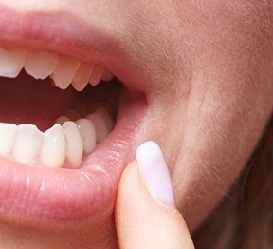 Stomatitis is the most common inflammation of the oral mucosa. As a result, extremely painful sores of small size form in the mouth. Children are subject to stomatitis much more than adults.
Stomatitis is the most common inflammation of the oral mucosa. As a result, extremely painful sores of small size form in the mouth. Children are subject to stomatitis much more than adults.
Symptoms of stomatitis differ little in children and adults, but the reasons for the appearance of this disease can be different. About 20% of the world's population has an illness, almost every second pregnant woman.
Timely treatment can prevent the chronization of the pathological process with the timely detection of pathology. The factors that provoke stomatitis can be local or common - trauma, allergy, virus, fungal or bacterial infection, irritation of the oral cavity.
The most common forms of stomatitis: aphthous, viral (herpes), candida (thrush of the oral cavity). Among those who have ever suffered from any form of stomatitis, a large percentage of people who are subsequently relapses of this disease.
Treatment of stomatitis depends on the cause of the disease and includes: local and general therapy - taking antibiotics, antifungal medicines, hormonal anti-inflammatory drugs, etc.
Causes of stomatitis
Stomatitis can act as an independent disease and as a symptom of systemic pathologies. To date, medicine does not have accurate data on the causes of stomatitis on the lip and in the human mouth.
This can be the penetration of microorganisms - pathogens of infection, which are activated in the oral cavities, and various diseases of the gastrointestinal tract, and the ailments of the cardiovascular system of the body. In the highest percentage of cases, the disease is a consequence of a bacterial, viral or herpes infection.
At least several factors that cause this disease have been identified. Any of them, or several at once, can lead to the formation of sores:
- toothpastes and mouth cleaners containing lauryl sulfate;
- mechanical trauma;
- emotional or mental stress;
- power deficiencies;
- allergy and hypersensitivity;
- prolonged use of antibacterial, antiarrhythmic, antihypertensive, anti-inflammatory drugs and other medications;
- hormonal changes;
- insufficient hygiene of the oral cavity;
- poorly made or poorly installed dentures;
The occurrence of stomatitis and other types of aphthous ulcers is also directly associated with certain diseases. It is believed that the disease occurs when, for reasons that are not yet known, the human immune system reacts to the appearance of molecules that it can not recognize.
In addition, they can occur when there are violations in the technique of dental manipulation. In most cases, treatment of stomatitis can be carried out at home.
Types of stomatitis
Depending on the causes of the disease, it is common to divide stomatitis into different groups:
- Catarrhal- the most common defeat of the oral mucosa.
- Fungal, it is also called thrush, often occurs because of yeast-like fungi of the genus Candida.
- Herpetic- is caused by the herpes virus. As a rule, it occurs in children from one to three years old and in young people.
- Bacterial- occurs when the infection gets into the injured mucous membrane.
- Aphthous stomatitis - carries its name from the word "aphtha". The cause may be diseases of the gastrointestinal tract, allergic reactions, viral infections, rheumatism, as well as heredity.
- Ulcerative. This disease is accompanied by a high morbidity, increasing when eating and talking.
- Enterovirus vesicular. This species is highly infectious among young children.
Whatever the reason, the first stage of stomatitis treatment should be to visit a doctor and conduct professional cleaning of the oral cavity. This will quickly cure stomatitis and avoid further relapse.
Symptoms
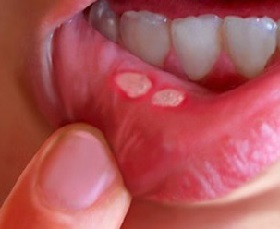 The most typical signs of stomatitis are hyperemia of the oral mucosa, puffiness, burning sensation, itching, often ulceration and bleeding.
The most typical signs of stomatitis are hyperemia of the oral mucosa, puffiness, burning sensation, itching, often ulceration and bleeding.
It should be remembered that stomatitis and its symptoms largely depend on the cause of the disease. As a rule, in adults with this disease, the following main symptoms are observed:
- formation on the oral mucosa of painful sores of round or oval shape surrounded by a red halo, with a diameter of 1 mm to 10 mm.
- Pain and discomfort during a meal or conversation.
- increased sensitivity of the tongue.
- the presence of small watery vesicles, which bursting, leave behind erosion.
- increased saliva.
- reddening of the mucous membrane of the mouth.
- bad breath.
- possibly an increase in body temperature.
Pain and discomfort are the very first and unpleasant symptoms of stomatitis, they appear even before the redness visible to the eye in the catarrhal process or ulcers and aft with ulcerative and aphthous stomatitis.
Note that depending on the form, causes and type of ailment, it can be contagious, that is contagious. If the existing symptoms of stomatitis are accompanied by inflammation of the mucous membranes of the nose and genital organs, as well as the eye, this may indicate the presence of Behcet's syndrome.
What does stomatitis look like?
A small selection of photos: how does stomatitis look in the mouth, on the tongue or lip.
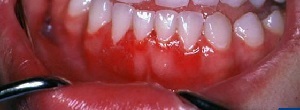 On the gum
On the gum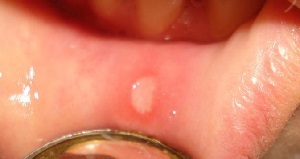 On the lip
On the lip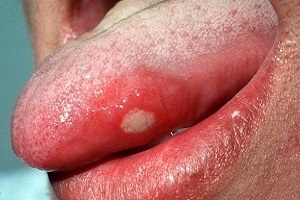 In the language
In the languageSigns in children
Often, the disease occurs in children of different ages. Characteristic signs of children's stomatitis are:
- anxiety, irritability, tearfulness;
- reddening of the mucosa of the superficial layer of the mouth;
- swelling and swelling of the gums and the inner part of the lips and cheeks;
- whitish formations in the tongue, on the lips in the form of "curd" plaque;
- decreased appetite, the child refuses to breast;
- education on the mucosa and in the corners of the mouth of a small size of sores.
All in all will give you a complete basis to determine the presence of stomatitis in a child. To know exactly how to treat stomatitis it is necessary to make an appointment for a consultation with a doctor, he will prescribe the necessary drugs and prescribe the appropriate treatment at home.
Diagnostics
To identify stomatitis, the doctor usually first examines the patient's medical record, and then begins a visual examination of the oral cavity. There are no special medical tests (for example, biopsy or culture studies) to identify stomatitis. The main sign of stomatitis is the appearance of ulcers, their location and the fact that stomatitis is a recurrent disease.
In addition, with stomatitis, the tissue directly surrounding the ulcer has a normal, healthy appearance, and the patient himself does not experiencing any bright systemic symptoms (for example, there is no fever or poor health). However, with advanced forms of stomatitis, especially in children, there are multiple ulcers, fever, deterioration of well-being.
Treatment of stomatitis
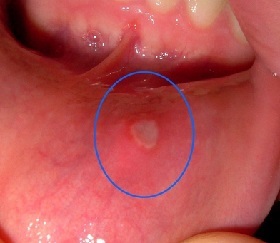 Most often the ailment passes independently for 1.5-2 weeks.
Most often the ailment passes independently for 1.5-2 weeks.
There are several methods for treating stomatitis in adults: topical treatment with mouthwashes, and general treatment, which if necessary includes antibiotics, hormones and other drugs.
Although the means for the complete cure of stomatitis does not yet exist, there are various ways and drugs with which you can reduce the soreness and the duration of its course.
At home, you can rinse the mouth daily with solutions of antiseptic products several times a day - you can use the water infusions of chamomile, calendula in a warm form, 0.05% aqueous solution of chlorhexidine or miramistine or methylene blue, a pale pink solution of potassium permanganate.
Ulcerative elements are lubricated with benzocaine, lidocaine, trimecaine, and also with aloe or calanchoe juice, these substances not only reduce soreness with stomatitis, but also cover the eroded areas with a protective film. Before applying any medication, be sure to consult a doctor, carefully read the attached annotation.
During the treatment of stomatitis should adhere to a diet - not recommended the use of spicy, salty or acidic foods. Food should be neutral in acidity and not cause additional irritation to the mucosa. To determine exactly what to treat stomatitis in the mouth - it is necessary to determine its shape, and afterwards to seek suitable treatment. For this purpose it is necessary to descend or go to the doctor.
How to treat stomatitis with folk remedies
To cure stomatitis in the home, you can use proven folk remedies. They will get rid of unpleasant symptoms, and help to bring the recovery closer.
Please note that treatment with medicinal herbs is possible in adults, unless there are other serious symptoms (a significant increase in body temperature, the appearance of blisters on the skin, worsening of the general condition, etc.).
- Dailyrinse your mouth with a saline-soda solution. To make it, add a teaspoon of salt and a pinch of soda to a glass of water.
- Rinsing with hydrogen peroxide. 1 hour a spoonful of peroxide is enough for 0.5 glasses of warm water. You need to be careful and do not swallow the solution.
- Kalanchoe and scarlethelp to remove inflammatory changes in the oral cavity. To prepare a remedy, you can rinse your mouth with Kalanchoe juice and scarlet.
- Calendulaalso helps to relieve inflammation of the oral mucosa during stomatitis. For the preparation of calendula infusion it is recommended to pour 1 tablespoon of dried flowers with a glass of water and cook on low heat for 10 minutes. Then cool and strain. The resulting infusion rinse the mouth 5-6 times a day.
- Main ingredientegg white- a very popular folk remedy for the treatment of infectious stomatitis. You need to wash the chicken egg and let the protein in the floor of a glass of warm water, beat. Make mouthwashes with this solution every 2 hours.
- To a sore spot, you can applyfreshly squeezed potato juice. To prepare the medicine, the potatoes are cut into small slices and passed through a meat grinder. The resulting juice is used for treatment.
- Garlic. 1 tbsp. l. mashed garlic mixed with 1 h. l. kefir or yogurt. Distribute this mass over the surface of the sores. It will burn, but it is necessary to suffer. Do 3 times a day.
Treatment of stomatitis in children by folk remedies is a separate category. A lot of drugs and drugs that can be used by adults are not suitable for a child's organism, so the treatment is carried out only by a doctor. Do not experiment.
Prevention of stomatitis
In order not to develop stomatitis, and in case of its chronic course avoid frequent exacerbations (relapses), follow simple rules of prevention:
- Do not eat food that causes allergies;
- if there are braces, dentures properly take care of them;
- Avoid stress;
- avoid traumatization of the oral mucosa;
- brush your teeth 2 times a day, including using dental floss;
- choose non-irritating oral care products;
- use multivitamins in spring and autumn;
- Visit the dentist once every 6 months to exclude the appearance of caries and the loss of seals.
Complications
Improper self-treatment can lead to serious complications, for example, generalization of infection, damage to the teeth.

How to choose probiotics for the intestine: a list of drugs.

Effective and inexpensive cough syrups for children and adults.

Modern non-steroidal anti-inflammatory drugs.

Review of tablets from the increased pressure of the new generation.
 Antiviral drugs are inexpensive and effective.
Antiviral drugs are inexpensive and effective.



